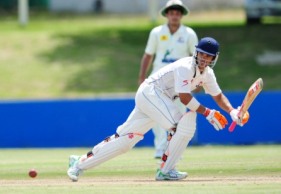The 2008 end-of-year tour to Australia will always be a special memory for Jean-Paul ‘JP’ Duminy, because it was then that he really cemented his place in the South African Proteas national team. The left-handed batsman and right-arm off-spin bowler had played for the national under-19 team in 2003 and made his debut in the national One Day International (ODI) team in 2004, but inconsistent form with the bat had seen him in and out of the team. Then in 2007 his batting started to click and he began to knock on the Test team door.
Called up for the first Test in Perth, JP scored 50 runs in the second innings and hit the winning runs after putting on an unbroken century partnership with AB de Villiers, then calmly stroked 166 in the second test first innings to save South Africa from a huge deficit, and the team went on to post a terrific nine-wicket win. And then in the third test he took his first wicket and also an incredible diving catch while sprinting full speed toward the boundary.
SPRINTS AND SHUTTLES
Thanks to his elegant batting, quick running between wickets and heroics in the field, JP has gone on to become one of the country’s most reliable international players, in all three formats of the game. And he says much of his success is down to his fitness. “The key is to train according to the type of player you are. Base fitness is key, so the odd long run is good from a test or first class cricket point of view, but specific training is what gets you through the tough periods. As a batsman, I prefer doing sprints and shuttle training, because that’s the bulk of the work I do during the game.”
JP, now 27, is currently contracted to play his domestic cricket for his hometown team, the Cape Cobras. He has also played County Cricket in England and was a high-profile ‘buy’ for the Mumbai Indians in the Indian Premier League (IPL). When asked if there is a difference in the pace of these various levels of the game, he says it isn’t that noticeable. “Things seem to happen a little bit quicker at international level, especially in the shorter formats of the game, but our fitness requirements are the same, because the national team medical staff wants domestic players to be at the standard of the national players if they get the call-up.”
That fitness, coupled with his natural agility and speed, has seen JP become one of the best fielders in the world, and when lined up alongside players like AB de Villiers, Herschelle Gibbs and Faf du Plessis, he has helped make the South African fielding circle extremely difficult to break. Naturally, a cricketer’s body takes a hammering from all the sprinting, diving, stretching, sliding, twisting and bending, but JP says he uses fitness training to get through that. “Batting, bowling and fielding all take a lot out of you, so I enjoy a bit of physical training before my net sessions.”
CHASING HONOURS
JP recently helped the Cobras win the national One Day Series Final against the Chevrolet Eagles, thus giving the franchise its third trophy in a year and cementing the Cape side’s dominance in domestic cricket, but JP is already looking ahead to winning more international and domestic honours. “If I do the hard work, the rewards are endless. A healthy, strong, fit body always contributes massively to your performance, so if I put in the work, I will see the results, and hopefully become a regular member of the Test squad. My aim is to be the best batsman in the world in any format.”
JP’S INTERNATIONAL STATS *
Tests: 12 matches, 518 runs (1 century, highest score 166); 11 wickets (best of 3/89); 12 catches
ODI’s: 81 matches, 2289 runs (2 centuries, highest score 129); 22 wickets (best of 3/31); 35 catches
T20: 32 matches, 715 runs (highest score 96); 5 wickets (best of 1/3); 16 catches
* Correct at 15 December 2011

